Rebecca Gold Project
The Rebecca Gold Project comprises ~160km2 of tenure located approximately 145km east of Kalgoorlie, covering a greenstone belt on the eastern margin of the Norseman-Wiluna Greenstone Belt. The belt lies at the southern end of the Laverton Tectonic Zone, a regionally important structural corridor that hosts multiple gold camps.
The project contains three advanced and growing gold discoveries – Rebecca (previously named Bombora), Duke, and Duchess (previously named Redskin), in which gold mineralisation is hosted by broad zones of disseminated sulphides in gneiss. The boundaries of each system are only partially defined and offer potential for high grade plunging positions internal to the zones.
In February 2020, Apollo declared a combined 1.035 million ounce Mineral Resource1 at the Rebecca Gold Project, across three deposits and wholly constrained within optimised pit shells. The flagship Rebecca deposit contributes 775,000 ounces, of which 550,000 ounces are at Indicated category. On 20 April 2021, Mineral Resource estimates were revised for the Rebecca, Duchess and Duke deposits following infill and step-out RC and diamond drilling completed in 2020. Total combined in-pit Mineral Resources now stand at 29.1 Million tonnes at 1.2g/t Au for 1.105 Million ounces of gold, 74% of which is at Indicated status.
While there are many additional financial considerations to be addressed in future economic studies, the delivery of more than 1Moz gold in Mineral Resources, with more than 800,000 ounces in the Indicated category, is an exceptional outcome. The Mineral Resource sits well within WA’s Eastern Goldfields gold mining district, looks robust at current gold prices, is continuous at a variety of cut-off grades and has scale to support future commercialisation of the Project.
The Project will continue to be the focus of activity going forward. Drilling will test a pipeline of new exploration targets as well as working through ongoing resource delineation and step-out drilling as the Company works toward options analysis, and potential development.
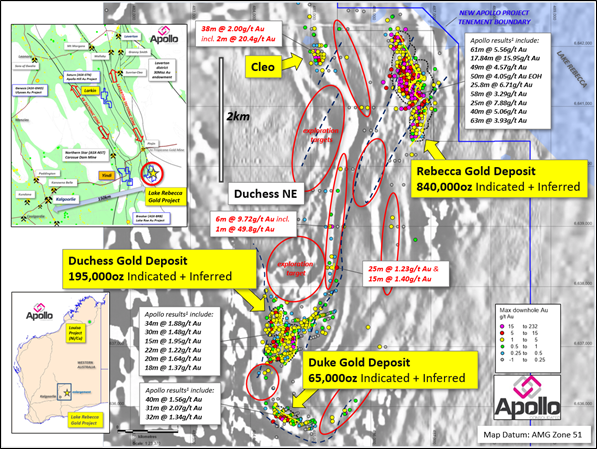
Figure 1. Rebecca Gold Project and location of Rebecca, Duchess and Duke gold deposits), showing outline of $A2,250 optimised pit shells, and all RC and/or diamond drill collars1,2, colour-coded for peak downhole gold values. Refer to Notes 1 and 2 for details of previous reporting of all RC and diamond drilling activities. Red areas are priority exploration targets for first pass drill testing.
About Rebecca Deposit
Apollo’s drilling at the Rebecca Prospect during 2012 first demonstrated the potential for high grade gold shoots within the broad anomalous envelope at this prospect, with a reverse circulation intercept of 42m @ 7.75g/t Au1. In August 2017 inaugural core hole RHD04 returned outstanding gold intercepts, including 17.84 @ 15.95g/t Au and 49m @ 4.57g/t Au, corresponding to wide zones of strongly sulphidic alteration1. These two intercepts intersected the upper part of what is emerging as a significant body of gold mineralisation named the Jennifer Structure (previously ‘161 Lode’), a surface that has now been defined over 300m along strike, approximately 250m vertical and up to 25m true width.
Drilling northward from Jennifer resulted in the delineation of the Laura and Maddy Structures, which have delivered wide zones of 1-3g/t Au grade mineralisation in west-dipping sheet like zones. Drilling during early 2019 has also located new mineralisation in an area some 200m to the south of Jennifer.
Continued drilling has delivered a series of hits in the hangingwall (west) side of the main structures, including down-dip extensions to previous intercepts which fall within the optimised pit shell but outside previous Mineral Resource boundaries. These may add to future resource estimations at the deposit. Additionally, RC exploration drilling on infill sections in a lightly drilled ‘saddle’ area in the optimised pit shell just to the south of the Jennifer structure intersected two west dipping sulphidic mineralised structures, and a series of solid intercepts. The results may assist in removing or reducing the ‘saddle’ and therefore optimise future mine design.
Shallow drilling has also identified new near-surface mineralisation in places along the footwall (east side) of the deposit, indicating strong potential for further drilling to provide mineralisation to a future mine plan. The strike and dip extensions of these intercepts are under-explored and will receive continued RC drilling.
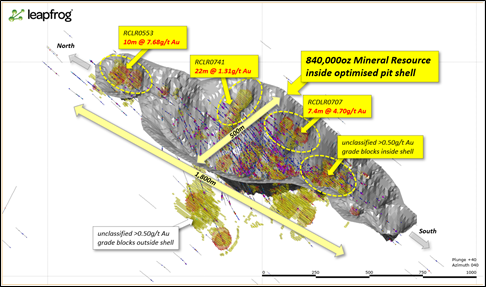
Figure 2. Oblique view Rebecca deposit looking to the NE showing optimised A$2,250 pit shell. The pit shell contains a combined Indicated & Inferred Mineral Resource of 840,000oz gold at 1.3g/t Au (Table1) of which 74% of material is at Indicated Mineral Resource status. Coloured mineralised blocks and intercepts shown within the pit shell are not drilled to a sufficient density to receive Mineral Resource classification and represent key resource definition targets going forward. All RC and/or diamond drill holes shown
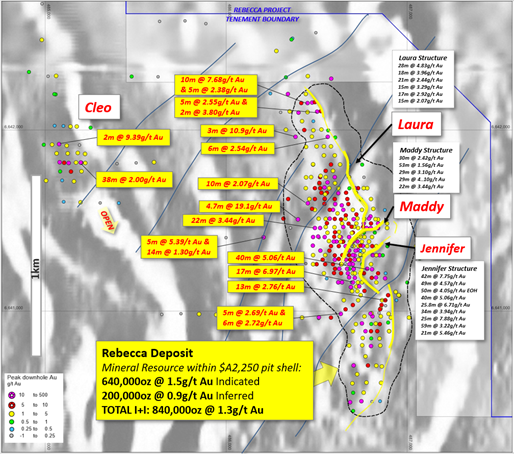
Figure 3. Plan view Rebecca gold deposit showing boundary of optimised A$2,250 pit shell, and RC and/or diamond drill collars colour coded for peak downhole gold assay on aeromagnetic image. Location of the main Jennifer; Maddy & Laura mineralised structures projected to base of oxide as yellow linework. Yellow highlighted gold intercepts are selected drill holes completed since the Feb 2020 Rebecca Mineral Resource estimation. *Refer to Note 1 for prior ASX: AOP reporting.
The Rebecca mineralised corridor remains open over its more than 1.7km in strike, hosts multiple mineralised positions with excellent volume potential and compelling new drill targets continue to emerge.
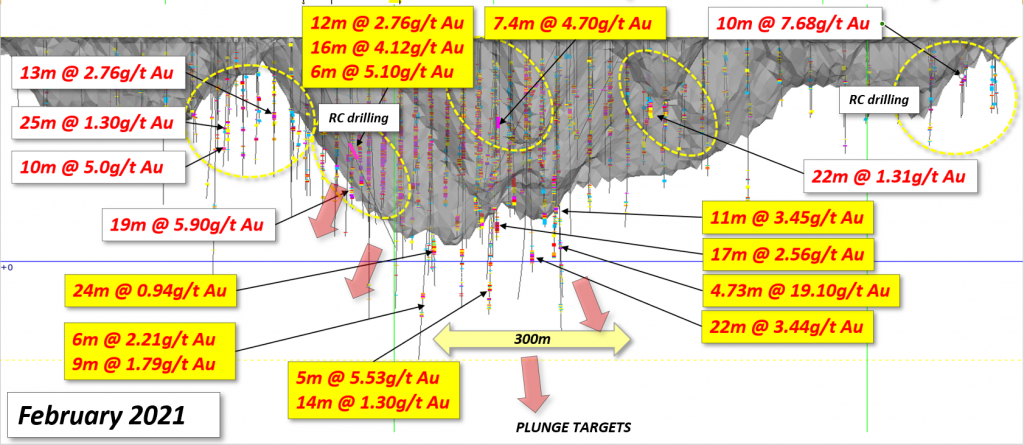
Figure 4 Long-section view of gold mineralisation at the Rebecca deposit (looking west), with drill intercepts below Mineral Resources shown, drill hole pierce points colour coded for sum of contained gold in the drill intercept. Note: only the material within the grey shaded optimised pit ‘shell’ was reported in maiden 775,000oz Mineral Resource estimation.
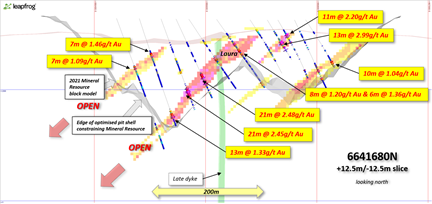
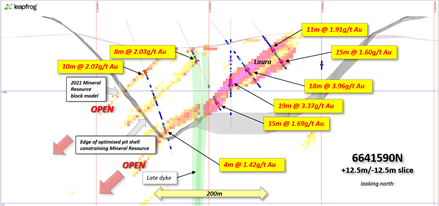
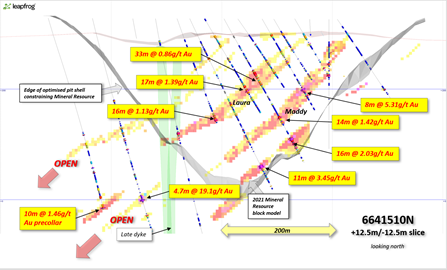
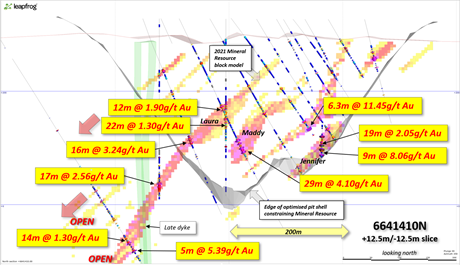
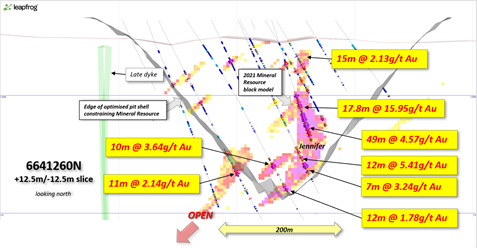
Figures 5-9 . Rebecca 6641680N, 6641590N and 6641510N cross sections looking north showing RC and/or diamond drill strings colour coded for downhole gold values, Mineral Resource blocks & optimised $A2,250 pit shell. Significant gold intercepts labelled. *Refer to legend for downhole and block grades and Note 1 for prior ASX: AOP reporting
Whilst the Rebecca Prospect remains the primary focus for drilling the Company is also expanding exploration through the under-tested areas surrounding the Rebecca project.
Duke & Duchess
The Duke and Duchess prospects are located 4-5km to the south of Rebecca and had received historical RC and diamond drilling by 1990’s explorers, but at a density unsuitable for the definition of individual Lode surfaces. Apollo has carried out a sustained program of infill drilling to bring the two deposits to Mineral Resource status.
Disseminated sulphides in this area respond well to IP geophysical tools, and extensions to existing IP grids during early 2019 have delivered strong strike-extension targets.
Duchess
The Duchess mineralised centre occupies a broad area approximately 1200m long and 400m wide, located approximately 4km southwest of Rebecca (Figure 2). The area is characterised by widespread sub-horizontal layers of weakly mineralised (0.1-0.5g/t Au) material in the lower oxide profile, and multiple north tending & west-dipping disseminated sulphide structures in underlying fresh granodiorite and diorite gneiss.
The Duchess deposit is reported at Inferred Mineral Resource and totals 5.7Mt at 1.0g/t Au for 180,000oz at a 0.5g/t Au cut-off and constrained within a A$2,250 pit shell complex that extends over 900m strike, up to 500m width and to 190m depth. In places the Duchess optimised pit shells are limited by drilling data, an indication that continued step-out drilling may add additional material to the in-pit Mineral Resource inventory.
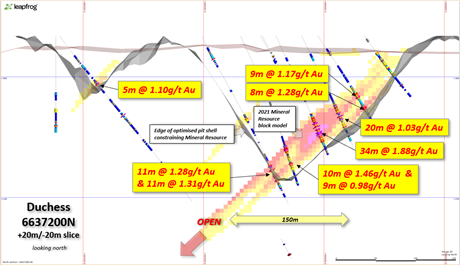
Figure 10. Duchess 6637220N cross section looking north showing RC and/or diamond drill strings colour coded for downhole gold values, Mineral Resource blocks & optimised $A2,250 pit shell. Significant gold intercepts labelled. *Refer to legend for downhole and block grades and Note 1 for prior ASX: AOP reporting.
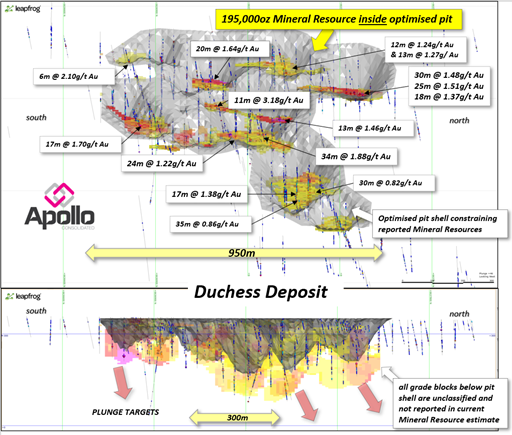
Figure 11 . Duchess deposit views looking west with all RC and/or diamond drill sections and grade blocks >0.50g/t Au. ABOVE: Oblique view looking west and downward parallel to mineralised structures showing key mineralised structures, selected intercepts and grade blocks within boundary of optimised $A2,250 pit shell. BELOW. Long section view looking west showing extend of pit shell and grade blocks extending beyond the shell. *Refer to legend for downhole and block grades and Note 1 for prior ASX: AOP reporting
Duke
Gold mineralisation at Duke extends over at least 400m of strike and is hosted by a near-vertical disseminated sulphide lode with good down-dip continuity. Apollo’s limited RC drilling here successfully intersected wide zones of disseminated sulphide mineralisation and increased foliation and included intercepts of 35m @ 1.41g/t Au and 26m @ 1.60g/t Au1. Mineralisation remains open eastward, where historical drilling is orientated sub-parallel to strike.
The Company sees strong potential for higher grade mineralisation along the mineralised surface, and plans infill drilling.
The Duke Mineral Resource is at Inferred status and totals 2.3Mt at 1.1g/t Au for 80,000oz at a 0.5g/t Au cut-off constrained within a single A$2,250 pit shell.
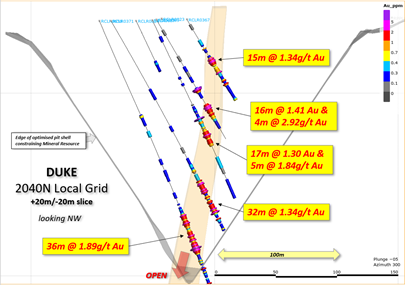
Figure 12. Duke cross section 2040N (local grid) looking northwest showing RC and/or diamond drill strings colour coded for downhole gold values & optimised $A2,250 pit shell. Significant gold intercepts labelled. *Refer to legend for downhole and block grades and Note 1 for prior ASX: AOP reporting

Table 1. Rebecca gold deposit Mineral Resource by Resource Category at varying gold cut-off grade. All numbers are rounded to reflect appropriate levels of confidence. Apparent differences may occur due to rounding
